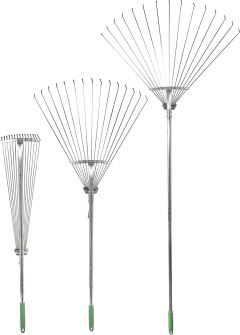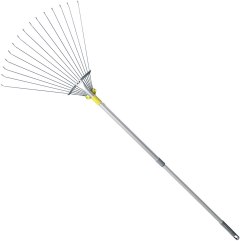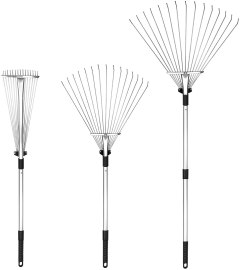BestReviews is reader-supported and may earn an affiliate commission. Details

A highly rated garden rake recognized for its locking switch and durability.
Length extends from 32 to 62 inches. Rake head is adjustable from 7 1/2 inches to nearly 20 inches. Telescoping handle is easy to handle. Lightweight and portable.
Some customers wished it was heavier for stability.

A leaf rake with expandable width as well as the ability to fold down and store compactly.
Made with galvanized steel. Rake feels sturdy yet lightweight. Head can be adjusted to a width of 8 to 23 inches, which is helpful in smaller areas such as flower beds and corners. The telescopic handle extends from 32 - 63 inches, as needed.
Not the best option for heavy-duty jobs.

This popular model is sure to impress with longer handle and its ability to extend and fold into desired width.
63-inch long handle for larger reach. Adjustable head folds 7 to 22 inches to fit small spaces. Metal construction. Lightweight.
A few customers thought the head was too narrow even when it was fully expanded.

A useful garden rake with an easy-to-use, lockable extender handle and head that expands or folds.
Aluminum and rubber handle locks into place and adjusts. 7-23" expandable rake head for tight spaces. Good for garden plot debris.
Not particularly sturdy for heavy duty use.

Coming with an added extender handle, this garden rake makes for comfortable use no matter the height of the one using it.
Rake head expands to 23 inches or folds down to 8. Pole length can be adjusted from 24 inches to 63 inches. Rust-preventable steel handle and teeth. Easily stored in small spaces.
Some customers stated that the handle was weak.

We recommend these products based on an intensive research process that's designed to cut through the noise and find the top products in this space. Guided by experts, we spend hours looking into the factors that matter, to bring you these selections.

Yard work is tough. It can also be expensive. If you purchased a single tool for each gardening need, it wouldn't be long before you had to buy a second shed. To save money and space, it’s wise to consider purchasing versatile implements. An adjustable garden rake is the perfect example of a tool with a high degree of flexibility.
The best adjustable garden rake will be adaptable to your precise needs. Whether you want to clear out some debris between delicate plants in your garden, or you need to remove an abundance of leaves from a large yard, an adjustable garden rake can tackle the task.
If you'd like to learn more about adjustable garden rakes, how to rake without injuring yourself, and the two main types of adjustable garden rakes to consider, keep reading. If you're ready to purchase now and just want some highly rated suggestions, feel free to peruse the hand-picked models that we've spotlighted on this page.

The most important choice that you need to make regarding adjustable garden rakes is which kind to get. There are two main types, so the choice is fairly straightforward.
The magic of an adjustable leaf rake is that it can spread out like a paper fan to cover a larger work area. However, if you need to do some detail work around a fence or air conditioning unit, the rake can collapse to fit into tighter spaces. Adjustable leaf rakes are light-duty tools used for superficial lawn cleaning. They’re effective for gathering grass clippings, leaves, and other small debris. An adjustable leaf rake is like having a broom for your lawn.
A thatching rake is a heavy-duty tool with sharp, curved blades on either side of the head. The main purpose of this tool is to break up thatch, a matted and entangled layer of organic matter (both living and dead) that accumulates around the base of the grass in your yard. While small amounts of thatch may be beneficial, too much can damage your yard. The adjustable aspect of a thatching rake is the tilt of the head. The closer to a 90° angle you get, the deeper the blades cut into the thatch.
Width: The purpose of getting an adjustable rake is so it can do all the jobs you need it to do. Since each yard has different challenges, focus on the approximate width range that’s best suited to your yard. As a rule of thumb, an adjustable rake that can collapse down to around 8 inches is ideal for working around bushes and shrubs. When expanded, 22 to 24 inches is a comfortable size for most people; the wider you go, the more strain it can put on your back.
Length: Rake handles are between roughly 4 feet and 6 feet long. If you’re tall and you try to use a 4-foot rake, you’re going to wind up with a sore back from constantly bending. If you’re on the shorter side, trying to work with a 6-foot rake might be troublesome. The good news is that many adjustable rakes also have a telescoping handle, so you can adjust the length to be perfect for you.
You want your adjustable garden rake to be lightweight, but you also need it to be durable. Since wood tends to be heavy, most users prefer aluminum or fiberglass. Steel is a more affordable option than aluminum, and it will work just fine as long as it’s been treated to resist rust.
Tines: The tines on your adjustable rake need to be curved at the end (like claws) and springy (so they don’t dig into the ground). While most tines are flat, a few manufacturers use rounded tines for increased flexibility (side to side), but this isn’t an essential feature.
Lock: In order for an adjustable rake to be effective, the adjustment mechanism must lock firmly in place. If it’s prone to slipping, you’ll spend more time wrestling with the locking mechanism than you will raking the lawn. Look for a model with high marks in this area.
Grip: For comfort and a better grip, look for an adjustable garden rake that has a cushioned handle. Some manufacturers add a second cushioned section in the middle of the rake's handle for your other hand.
Leaf scoops: Gardease Leaf Scoops
These oversize, wearable leaf scoops allow you to grab large batches of leaves at one time and protect your hands from stickers and sharp twigs. You can even use them to spread mulch or gather fruit.
Leaf chute: Luster Leaf Leaf and Lawn Chute
This lightweight, durable corrugated plastic chute fits inside a standard 30-gallon yard waste bag to make filling it up with leaves an effortless task.
Reusable leaf bags: Glorytec Reusable Leaf Bags
If you've got a lot of leaves to collect, this three-pack of heavy-duty, reusable, 80-gallon leaf bags can help. Made from tear-resistant, water-repellent, UV-resistant material, these bags will last for many seasons.
Tarp: Bosmere Yard Waste Tarp
When collecting yard waste, not just any tarp will do. You need a durable model with handles to make it easy to transport. Bosmere's yard waste tarp is 49 square feet with a handle in each corner. It’s manufactured using UV-stabilized polyethylene to last a long time.

Inexpensive: Budget adjustable rakes cost between $10 and $15. These are either smaller hand rakes or less durable models that might not have the best locking mechanisms.
Mid-range: For a heavier-duty model with an ergonomic design that will be adequate for most homeowners, you only need to spend $24 to $35.
Expensive: Once you hit $40, you’re either considering a high-end adjustable leaf rake or a thatching rake with an adjustable head. In this range, you have to proceed with caution. If you've got your eye on an $80 or $100 model, carefully consider the features to determine if there is true value in the extra cost.
Compared to using a chainsaw, an adjustable garden rake doesn't seem that dangerous, but there are still plenty of ways to injure yourself if you’re careless. The following are a few safety tips to help you stay free of injury.

Q. I'm always sore after raking. Is there anything I can do to reduce the aches and pains?
A. Definitely. Since raking is a physical activity, you want to warm up in much the same way that you would before exercising. First, get your blood flowing with a short walk or even a jog, but keep the pace easy. This isn’t meant to tire you out. Then take a moment to gently stretch your back, shoulders, neck, arms, and torso. After that, you'll be ready to start your chores. When you’re finished, it is a good idea to end with some stretching as well.
Q. Is there a proper way to hold a rake?
A. First, you need to feel comfortable when holding a rake. Typically, one hand is at the back, on the handle, while the other hand is placed about a shoulder-length away. You need space between your hands to give you leverage, but reaching too far forward can put a strain on your back. It's a good idea to swap your hand position every few minutes by placing the opposite hand on the back of the rake, so you don't fatigue as easily.
Q. What is a good raking technique?
A. The most important element to remember when raking is to keep your knees slightly bent so you can step. Raking should be done in a series of smaller steps, not large reaches. Use your arms and your legs, not your back, to accomplish the task. If you find yourself moving your arms a great deal, or you get blisters quickly, that usually means you’re reaching too far. Think of raking more as an activity that uses the short, light dance steps of a boxer.
Get emails you’ll love.
Learn about the products you’re wondering if you should buy and get advice on using your latest purchases.
BestReviews wants to be better. Please take our 3-minute survey,
and give us feedback about your visit today.
